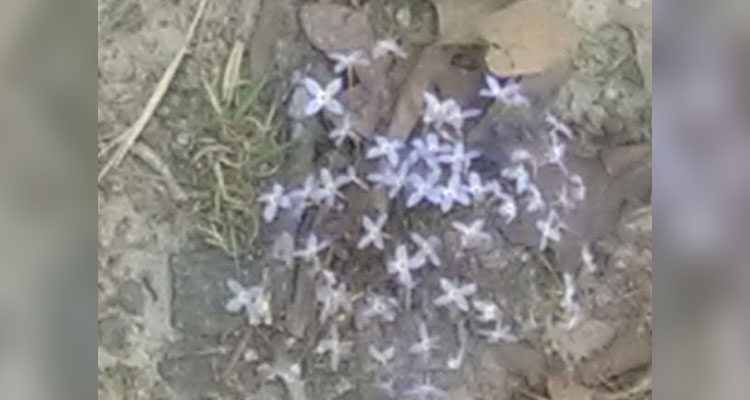Now that we’ve reached the month in which spring departs and summer debuts, let me tell you my thoughts of a little flower which began this spring season. This flower is an annual, but giving lasting, perennial pleasure in its sighting.
In contrast to the slow, green rise of the daffodil stalks above the ground, taking time to reach blooming height, after which follows the equally slow, teasing time of the bud’s opening into flower, a variety of tiny flower seems to be: ALL-OF-A-SUDDEN, THERE!
Though I can think of many present places in which this yearly “tiny flower phenomenon” is presented, I can think of no better place (probably, because I frequently walk there) than Danville’s Ballou Park.
As a child, I asked my mother of that little flower’s name; and after thinking a minute, she said, “Johnny Jump-Ups!”
I know now that their real name is “bluets,” but in some walled-off section of my mind, in my mother’s memory, I still refer to them as “Johnny Jump-Ups,” but never in speech.
A church friend told me she used to call them “Forget-Me-Nots.” To me, this emphasizes just how many varieties of “little blue flowers” there are, lending confusion as to which is which.
Instead of a five-pointed star pattern, like many flowers, the “bluet” flower consists of four petals in a cross-like arrangement. Starting at the outer edge, its petals are pale blue, trailing into white, and becoming yellow at flower’s center. The bluets’ center looks dark like a sunspot, in adjacent comparison to that “sun-yellow.”
The name “bluets” reminds me of the name of those tiny blue butterflies I would tell the school children about when I worked at the Danville Science Center. Those butterflies have wings not much bigger than the diminutive bluets’ petals. The common name of those butterflies is “blues.”
“Bluets” and “blues” are suitable, simple names for such delicate, “elemental” things of the plant and insect world. They seem so elemental they should be honored with places on the Periodic Table (of elements). Those one-syllable names are surely simpler than their defining Latin names in the journals of botany and entomology.
Whenever I first see them, the bluets seem to have sprung straight from the soil already in full bloom! I’ve never yet seen a single one of their unopened flower buds atop one of their spindly little stalks. To have appeared so suddenly, I get the feeling their blooms must have been hurried on, via the moon by night, and, of course, via the sun by day. It’s as if the bluet flower, fully open and pristine below the ground, rose from the earth, its petals un-smudged by the soil through which it dug itself out of the earth.
The article, which I googled, said, “Bluets grow in small clumps in open woods, with somewhat moist, usually acidic soils.”
Also, “Their habitat can be rocky, but moist soil, some moss with them, or semi-forest shade.”
These descriptions of the bluets’ habitat are familiar to me, not through prior reading, but through prior experience, long ago.
They describe the yard in which a little boy grew up, a yard with “rocky, but moist soil, some moss with them, or semi-forest shade.”
The little bluets’ growth conditions were my “growth conditions” as well!
Google said, “Bluets are an early source of nectar and pollen for tiny worker and sweat bees.”
So, just as early in “my season,” the bluets “nourished” me.






